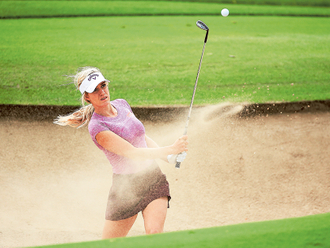
The 2016 edition of the Ryder's Cup is from September 27 to October 2 and to many of us, golf championships mean nothing or less. Mostly because we don't know what is going on apart from the 'hitting a ball with a club and it goes into a hole' part. Guides came up with a dummy guide for beginners to understand golf and hopefully, all of us will come to love this gentleman's game.
Course
A golf course has nine or 18 holes. For major tournaments, 18-hole courses are used. They have a grass surface, and each of the 18 holes comes with its own challenge.
Equipment
Clubs Most notably, a golfer has their own set of clubs. To the average philistine they may just look like a lot of sticks in a bag, but each club is different and offers the golfer a different option. There are three main types: woods, irons, and putters.
Note: You must never ever refer to the club as a stick or a bat in close proximity to a golfer or someone who enjoys the game as the said stick or bat may be used to injure you grievously.
A player is allowed up to 14 clubs in their bag
Woods are generally used to wallop the ball miles, such as when teeing-off (which is golfist for “start”), irons are used to get out of tricky spots or to chip onto the putting green, and putters are only used on the putting green to gently knock the ball into the hole. A golfer is allowed a maximum of 14 clubs in total. There are other types, such as hybrids.
Balls Balls are mainly white, but are sometimes coloured. They are covered in pock marks so they fly through the air faster.
Tee You will notice that at the start of every hole, a golfer uses a tee. A tee is a small pin that goes into the ground to keep the ball still and at a certain height. It can’t be used anywhere else but each hole’s respective teeing ground (the start point).
Glove No, not gloves, a single glove. Golfers wear one glove to prevent blisters and maximise grip on the lance of the club. The last thing they want is for it to slip through their hands.
Trousers The trousers might be funny to look at, but they are light and baggy to allow the golfer full swing.
Note: Try not to snigger
A glove, a tee, a ball, and an iron
The game
Summary The idea of golf is to get the ball in each of the 18 holes in the fewest strokes possible. The golfer tees off for each hole with the aim of getting the ball as close as possible to the putting green – or as close to the hole as possible.
Par You will hear the term 'par' a lot, and whether a golfer is 'under' or 'over' it. Under par is good, whereas over par is not quite as good.
The common par for a hole is three which means the golfer must try to get the ball in the hole from the teeing ground in three strokes. This par could be two, four and rarely, five.
If he or she does it two strokes for a 'par' of three, they are -1 (1 under par). If they do it in four strokes, they are +1 (1 over par). If they do it on three, their score is 0, they are therefore on par.
Note: The lower the score the better.
Scoring terms Naturally there are names for each of the different scores
| Score name | Meaning |
|---|---|
| Ace | Hole in one |
| Albatross/double eagle | Three strokes under par on a hole |
| Eagle | Two strokes under par on a hole |
| Birdie | One stroke under par on a hole |
| Par | The expected level |
| Bogey | One stroke over par on a hole |
| Double bogey | Two strokes over par on a hole |
Penalties As you would expect, there are penalties in golf that, unless you’ve been paying attention, can be quite confusing.
| Penalty | Penalty description |
|---|---|
| Out-of-bounds | 2-stroke penalty (the stroke you hit plus one penalty stroke). Play the ball from your last shot point |
| Whiff | Each time you swing for the ball counts |
| Unplayable lies | 1-stroke penalty. Place the ball (no nearer the hole) within two club lengths of the original spot; drop the ball as far back as you want, keeping the original spot between you and the hole; or return to the point from which you hit the previous shot |
| Water hazard | 1-stroke penalty. Play the ball from its original position. Play from as close as possible to the spot from which you played the previous shot. Or drop the ball behind the water hazard, keeping the point at which the original ball last crossed the margin of the hazard between the hole and the spot where you drop the ball, with no limit to how far behind the water hazard you drop it |
| Lateral water hazard | 1-stroke penalty. Play the ball from its original position. Place the ball outside the hazard within two club lengths of where the ball last crossed the margin of the lateral water hazard (but no nearer the hole), or within two club lengths from a Alternately, play the ball as it lies without grounding the club for no penalty |
Dos and Don'ts for spectators
Golf is some 600 years old, and in that time etiquette on the golf course has been considered one of the sport’s most important aspects. Each course or visiting tour competition will have their own specific rules, and these will be clearly publicised, so pay attention. However, here are some general dos and don’ts.
No talking
If you’re following a player around the course, remain totally silent when they are taking a shot – be it teeing off, a shot on the fairway, or on the putting green.
No phones
Turn your phone off or keep it on silent – if a PGA golfer is keyed up to win the European Tour on the last hole and he is interrupted by the hateful Samsung whistle then you are going to be the most-hated person on the planet.
No cameras
Don’t even attempt to take pictures or videos of the players while they’re out on the course. If there’s one thing Guides learnt at the HSBC Championship, it’s that the course officials will shout at you if you try to video the action. There is usually a designated area where photos are allowed, so learn where when you arrive.
Stand still
If you’re watching by the side of the teeing-ground, stand still. Fidgeting and fumbling will cause an unwanted distraction.
Keep your advice to yourself
Remarkably, there are some spectators who want to offer golf advice to professional golfers. At the HSBC Championship, Guides was following Bryson DeChambeau who, despite technically being an amateur, was actually leading the entire tournament after day one. Yet still, one fellow spectator kept offering advice and minute-by-minute updates on the weather. His guidance was not well received.
Don’t touch the balls
Generally the fairway is roped off to spectators, but sometimes a ball can stray into the rough (which is golfist for “that bit that isn’t part of the course”). Never, ever touch or pick up someone’s ball, even if no one is around. You don’t know if it’s still in play and if the player is coming to get it. Leave it alone.
Tallest at the back
Rather than follow a golfer around, some people opt to set up a picnic at a specific hole for the day. If this is the case, then do not get in their way. If you’re standing in a group then ensure the tallest people remain at the back.
Language
Never swear while on the golf course.
When to clap
After a player has made a shot, it is acceptable to lightly clap and, if it was a belter, offer congratulations. Try to refrain from excessive whooping.
Respect the players
Leave your emotions at the gate. If you don’t like a particular player, then keep it to yourself. Any heckling or abusive behaviour will see you ejected and barred.
Crossing the course
Never cross the fairway during play. There is a path that runs around the course that you should follow. However sometimes the path does cut through the fairway. For big tournaments it will be fenced off and opened by the officials between play. If it is not fenced off, look up the fairway to the teeing ground to see if the hole is being played. If it is, wait.
Pro golfer Paige Spirinac swings for the hole with the wood from the fairway
Other terms
Cup The actual name of the hole
Marker The flag stick, which helps identify the hole’s location from afar. It’s removed when the players arrive at the putting green
Rough The immediate ground surrounding the course or fairway. It is commonly an area with longer grass or isn’t as smooth. It acts as the border of the course
Out of bounds The area that is not part of the course
Sand Bunker Often used as an alternative to “sand trap”
Water hazard A body of water which will annoy players if their ball lands in it
Fairway The specific part of the course between the teeing ground and the putting green. This can be in either one or multiple sections
Putting green The super-smooth surface immediately surrounding the hole. Usually just referred to as the “green”
Wedge Type of golf club, similar to the iron but with a sharp angled face
Drive Usually the first hit of the ball with a driver club. The idea is to wallop the ball
Chip A short stroke used to chip the ball out of the rough or onto the putting green
Putt The light tapping of the ball in an effort to get it into the hole
Fore Players may shout “Fore!” when they drive the ball as a warning to other players who may further along the course
Caddy The player's assistant who carries the bag full of clubs
Golf courses in the UAE








